Since it's such a long winded consultation, as well as the site being less convenient to read and access maps, there's been a lot to take in. As well as the official notice being ominous. The following day, Abellio, Arriva and Go-Ahead provided employee notices whereby stating they'd lose 135 drivers (Arriva) and 350 drivers (GAL) respectively, both having discussions with Unite to maintain jobs. Cut short, the operators were best displeased with the consultation, so it seemed anyway with really similar wording to TfL's own one.
Fret not, enthusiasts on The Bus Forum have simplified it. There's a document Inner London with the changes simplified, thanks to user YX10FFN.
Read those and come back to hear my thoughts.
If you need a map to properly understand, Mike Harris (the legend behind many historical maps who also makes recent maps) created a Central London map of what the consultation entails.
Perhaps enter a petition, (here's one for Southwark), even if it might not save it in reality.
Many articles surfaced. Ham and High regarding 24/31 and Southwark News regarding the 12/78. As well as Brixton Buzz regarding the 45.
Time is ticking in thoroughly as 12 July is the limit, leaving a short time window for any build up of controversy or complaints.
The reason for the post being more than a week after it became live was because I delved into calculations using my spreadsheet.
PVR changes, route length changes, stand changes, corridor buses per hour changes. Nothing more than that though.
In short, the corridor changes in Central and the City.
Without further ado, I'll go from South to East to West to North.
--------------------------------------------------------------------------------------------------------------
South London
routes 12 45 521 withdrawn
changes to routes 3 53 59 77 133 148 171 507 C10
-------------------------
Colharbour Lane + Waterloo
routes 45 59 + 53 59 133 171 521
I started off with 45/59, and it was a bombshell that did disappoint from the get go.
| Exactly how many people get referred to St Barts Hospital from Brixton Hill compared to Kings College Hospital, Transport for London? |
TfL cite Clapham Park residents have a new Kennington link, though virtually no one goes there. Though, for arguments sake, say people do go Kennington. The 59/159 already provide that link nearby. So moving the 59 closer into Clapham Park when people already had to change in the first place, whether Hopper fare existed or not, is a very weak selling point. Kennington doesn't have a point of interest for shopping or leisure, and Brixton is a closer station for the tube.
I suppose East Street Market (on Walworth Road) isn't picked up by TfL as a key destination but alas, it's technically another link broken unless you count the entirety of Walworth Road to Brixton Hill as a link altogether.
Another thing the withdrawal of 45 doesn't address is the loss of capacity on Brixton Hill and Streatham Hill, but has the need to divert 59 from Streatham Hill.
During the 4% mileage cuts over the past 3 years, every central route imaginable has received frequency cuts of varying degrees, some harsher than others whilst some light.
Whether fortunate or unfortunate, all of Brixton's central routes (2 3 59 133 159, excluding 35) received frequency cuts. The 59/133/159 standardised to 8 bph each, when the 133 provided nearer 15 bph alone.
This is now in addition to a future 45 withdrawal which sees 6 bph lost from the corridor.
Pre-pandemic every bus on the inner A23 corridor would be fully packed, where routes 45/59 would be lighter loaded but relieve capacity from the other routes going further. Up to 73.5 bph.
Post-pandemic with work-at-home as well as changes in lifestyle, yet these routes are still performing almost no differently to before, as we've opened up for quite a while now. A route 45 withdrawal nets you 54.2 bph.
Majority of that traffic funnels into Brixton Station for the Victoria Line, whilst others for local traffic or other interchanges.
The 133
Extended to St Bartholomew's Hospital.
We've already established Brixton Hill loses it's hospital link but for some magical reason, the city workers at Bank apparently need a link to this hospital. Sorry, those in Inner London within the vicinity, Borough? Elephant? Thankfully it isn't rerouted away from London Bridge somehow since Guys Hospital is there.
The 59 and 133 are a bizarre selection to replace the pre-pandemic-powerhouse of Red Arrow 521. No doubt there are less people as a result of work-at-home and pandemic changing the world order, but still the short 521 with single deckers purpose-built with extra standing space make better use of dwell times with dual entry, as opposed to regular double deckers you only board from the front.
In the end, it's an exercise to reduce the amount of buses across London Bridge to Liverpool Street, which they've succeeded in. Even if 133's patronage to the city proper has declined (hint: pandemic), it still exists, proven by the Northern Line closure due to Bank station upgrades. Due to roadworks and pedestrianisation and closure of some streets, 133 had changes to it's entry into Liverpool Street with at one point paralleling 35 one-to-one, which it still wasn't a lightweight in that job as 35 got busier with the loss of 40's Aldgate section.
Rerouting 133 away from Liverpool Street will put even more strain on an already strained 35.
Route 53's cutback.
Once again TfL try their hand with the cutback, where the recent cut from Whitehall in 2017 had lots of complaints which saw it return to Whitehall to continue being in the vicinity of St Thomas' Hospital which many as far as Woolwich are referred to. Though in 2019 they tried their hand and succeeded with not enough complaints to force it to revert, so County Hall became the new terminus though it's really Lambeth North. Perhaps with momentum of other cuts of recent and cuts in this consultation they'll succeed again as other routes (withdrawal of 12, and more) will spark more attention than a cutback.
It is a shame, the 53 returning to Trafalgar Square or even Oxford Circus at a really high frequency (basically combining with 453) would be wonders, keeping the links it already has whilst 453's less used section north of Oxford Circus could be relegated to a less frequent route, instead of cutting 53 back to Elephant.
The 171 changing stands is a rehash of 468 changing stands for when 171 was cut from Holborn to Elephant. They're even reusing the same words along the lines of "allowing opportunity to share stops" for 171/68/168 now used for 53/148/453.
The withdrawal of 521 would mark the final nail of the coffin for the once pioneer Red Arrow network which included multiple routes that all had single deckers with high standing capacity moving workers into the city from terminals, most were fused into normal routes and/or changes to existing central double deck routes until only 507/521 remained with no need to replace them until now. Albeit not the older generation of Red Arrow but still a shame for it to die but in the same vein, life moves on.
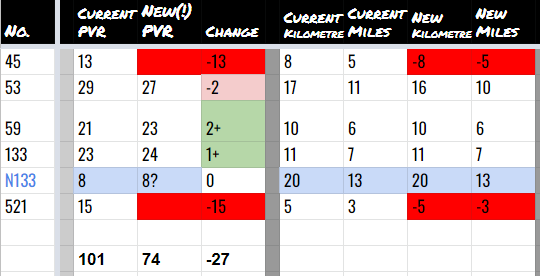 |
| My estimated PVR/length changes 9870 links broken (12% of daily trips in both directions). |
-------------------------
Horseferry Road
The 3 77 507 C10
The 3 to Victoria
Upon seeing the route 3 involved in the consultation I did dread what in the heavens was in store, lo and behold it's a reroute away from Westminster. A shame, since this is a link that's been provided for nearly 90 years under both 3/159 and now the 3 is rerouted away via Horseferry Road to Victoria. This benefits pretty much only those as far as Kennington, since anyone from Oval has 36/185, anyone from Brixton has the much quicker 2 and Victoria Line, anyone south of Brixton can still change onto 2/Victoria Line and still be quicker. The direct link to Victoria from Crystal Palace is also reaching it when Southern and Southeastern (albeit Herne Hill/West Dulwich) also go to Victoria. Whereas only 3 provided a service to Trafalgar Square when it went there until you reach Brixton with 159 as company.
My dread was the section going altogether but now with the 3 going to Victoria, it's seemingly set for failure and I won't disagree. The 3 still has it's local merit in going from Lambeth Palace via Millbank to Westminster. Yes it's much less used than the previously-significantly-more-frequent-159, though this was not the case prior to it's cutback from Oxford Circus.
In the end, Millbank will only have one day route: 87. Two night routes: N3 and N87. Good thing N3 isn't getting cut from Oxford Circus for what it's worth.
The 77's reroute.
Nothing major, just a change of stands. Seemingly something that was in the works since word of it's Concert Hall stand being in jeopardy was apparent and this consultation confirms that stand is dissolving for redevelopment purposes, so 77 takes 507's spot. Simples.
The C10 reroute.
As if piggybacking the above, the C10 reroute covers 77's spot via County Hall and the other side of Waterloo Station. Not sure if it was necessary. There is time penalty in going via Waterloo than via Lambeth North. The 188 and 381 provide Waterloo links, so adding another is perhaps extra? On the other side, Victoria keeps it's Waterloo link which is also provided by 211(to-be-507).
507 restructure.
In reality this is 11 renumbered and rerouted at Westminster to Waterloo. The irony of the number 507 being used when 211 itself replaced a Red Arrow route 511 (Waterloo-Victoria). Ever since the 11/311 change failed as it involved cutting 19 from Battersea to Holborn, something which Chelsea vehemently rejected thus TfL went back to the drawing board, not usual but it involved a richer area with money which influences anyone if used in certain ways.
Alas, the 11 would not remain in it's city section untouched now at the borderline high frequency of every 12 (low frequency being every 15 and lower) though instead of it being isolated into Trafalgar Square to Liverpool Street in the 11/311 plans, it's outright lost to a reroute of 26 to Victoria.
My thoughts on it 11/507/whatever-it-will-be; inevitable and nothing unfortunate. The 11's city section much like other routes had dwindled, the 11 in particular being of the slowest bus routes which clearly drove patronage away. Perhaps regulation not being overdone would help but hey ho.
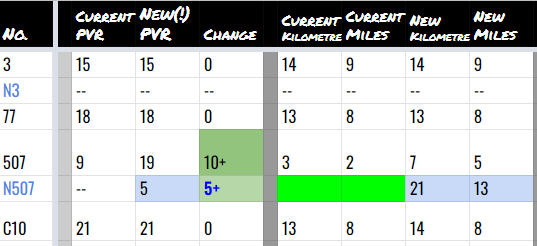 |
| My estimated PVR/length changes. 3306 links broken (6% of trips in both directions) |
-------------------------
Walworth Road
The 12 148
Whilst it does have the vibe of returning to history, what not with a Dulwich to Shepherd's Bush route again, albeit via Victoria instead of Oxford Circus. Oh yeah, Dulwich to Walworth Road all lose their Oxford Circus and Trafalgar Square links!
As word of the consultation was imminent was arriving, there were worse suggestions for replacing the southern section of the 12 to the point I literally did become numb to this one, almost a sigh of relief is what I felt, which is bad considering the major links lost in reality. Equally the 12 did suffer major patronage loss (it halved from it's peak of 13 million in 2010/11 to 6 million in 2019/20) ever since it's fateful temporary cut to Whitehall due to diversions, it was never the same. It only decreased, leaving only it's southern Elephant-Dulwich section alive, a section easily replaced, just pick the right route.
The right route in TfL's eyes is 148, a route with questionable reliability performance whether due to sheer difficulty or operational competence, but is not helped by 148 having a frequency reduction not long ago which further exasperated those concerns. Adding in a short extension via Peckham isn't going to help methinks.
 |
| My estimated PVR/length changes. 7840 links broken (21% of trips in both directions) |
-------------------------
According to the Equality Impact Assessments, the total amount of links/journeys broken:
21016 links broken,
My estimates of:
PVR change of -29. Length change of -17 km -11 miles.
 |
| GIF: Current and Proposed |
--------------------------------------------------------------------------------------------------------------
East London
routes 4 11 78 242 D7 N11 N242 withdrawn
changes to routes 15 26 43 47 56 100 135 211 236 277 343 388 476 507 D3 D8 N15 N26
new routes N135 N507
Clearly the 211 is an imposter from Among Us because it doesn't enter an East London borough at all, with other imposter friends claiming to be from other corners of London...
-------------------------
Commercial Street
The 15/135/242
What effectively happened is 242 extended to Crossharbour, with it's night service renumbered to fit. Which is an odd choice given the fact 414 and 430 aren't renumbered to "better match the route" with the long-known numbers of 14 and 74. Even more so when 135 is the newer route than 242 by a decade (135 in 2008, 242 in 1998). Once word of 242 being withdrawn came about, suggestions did kick into high gear. Right before the day of it being dropped, it was joked that 135 would be diverted along Commercial Street to replace 242. Et voila, the worst came to worst.
Well what would have certainly been worse was if 205 was diverted via Commercial Street again but that nightmare has been averted, if at the cost of the 135 being the chosen one.
In the end the new 135 would become neither a direct route, and a route that misses out Aldgate within a few inches, doesn't serve Liverpool Street which is a useful destination of 135, becoming a route on Commercial Street which also doesn't serve Aldgate. If any benefit could be spotted, Hoxton and Dalston have a better link to Stepney/Limehouse. The D6 would be quicker from Hackney to Crossharbour so scratch that assumption.
The 15/N15
They double run Aldgate Bus Station to sort of replace 135. Fair enough, not a fair compromise, but fair enough.
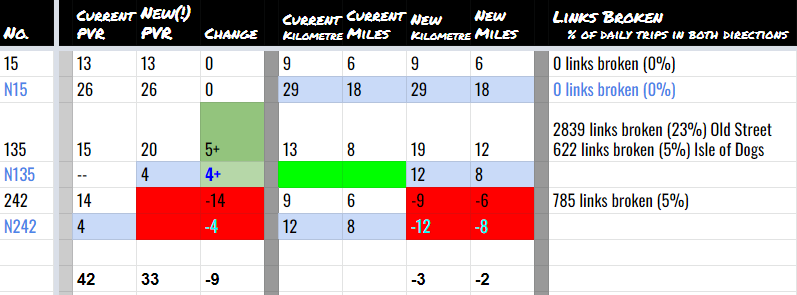 |
| My estimated PVR/length changes. 4246 links broken (11% of trips in both directions) |
-------------------------
Essex Road/Upper Street
The 4 56 236 476
236.
This is among the changes I have the least to say about, is what I thought. Though it seems the choice of replacing 4 between Finsbury Park and Archway was a single deck route 236. The more obvious choice would probably have been the 19, maybe even the 106 that's double deck at least. Perhaps a route that doesn't even Blackstock Road but that will break links, so far TfL have been avoiding breaking links where possible, with an important asterisk needed.
A history note, 236 when it became a cross-Finsbury Park route (Sundays only to Golders Green, ignoring peak hour only Stroud Green section), it suffered reliability issues more than it already had, becoming one of London Transport's least reliable route if not the least, full stop. The mistakes of it's extension was reversed and since it's eastern section was split into W15, the section that had a low bridge. The 236 currently has no restrictions from it becoming double deck, who truly knows what it is holding that, perhaps it's not even a consideration? It's seen Titans in the past.
56's extension
A no brainer, somehow a praise given TfL have chosen what's seemingly less optimal decisions but there wasn't a convenient other lab rat nearby. They wouldn't sacrifice 153's Liverpool Street section, now that's a surprise for you(!)
The 476
At this rate it's a surprise the route remains to live. It's been cut back from Euston to King's Cross by swapping 59/476's stands arrangements. Now it's being cut back from King's Cross to Newington Green taking 21's stand space which will be free once 21 replaces 271 (21 going to Archway remember?)
Many have touted the train of 73 fusing with 476. At this rate that would be better, as the links broken from 476's cutbacks aren't lost if 73 is extended to Northumberland Park. Yes the 73 is far more frequent, which seems to be why they haven't chosen that route, but have done so with 13/82 in 2017. A solution to that would be short workings, but TfL have eliminated every single one on day routes except 38 and 166. The 38 is very frequent still. The 166 stems from it being a two-in-one bus route, so it's Surrey section remains hourly, unfortunately.
Let's see how long 476 remains before it's cutback to, maybe Stoke Newington next.
 |
| My estimated PVR/length changes. 5822 links broken (9% of trips in both directions) |
-------------------------
Fleet Street
The 11 26 211 507
night routes N11 N26 N507
I've touched up on 11/507 in South London briefly so I won't repeat what I said. So effectively I'll be praising 26/N26's extension to Victoria as a replacement.
The 211 to Battersea Power Station is an interesting one. It does away with 11/211 paralleling as far as Westminster, keeping only 507 to the job. Perhaps in a bid to funnel people into the Northern Line but either way, it does create new links to King's Road and Fulham Road that 211 straddles both corridors.
One thing to note is 328 was envisaged to head to Battersea Power Station, but the 211 being chosen instead as they went back to the drawing board. I personally didn't see the merit but it's not a negatively received change, positive perhaps even. So well done I suppose.
I will slate 211 being in an East London proposal but alas, well done nonetheless.
 |
| My estimated PVR/length changes. 2824 links broken (7% of trips in both directions) |
-------------------------
Isle of Dogs and Wapping
The 100 135 277 D3 D7 D8
The D3 required me to double take.
Initially whilst reading the document (as that's what I've done first), I was confused with what D3's change was, sure it's going Crossharbour, but they've literally swapped 277/D3 a few years ago with D3 going to Leamouth. Turns out, D3 will be staying at Leamouth unchanged. It'd just turn into a route from Leamouth to Crossharbour. That's a hyper localised route! Rather, that's just a new 325 since that'd end up basically going from one side of Beckton to another side of Beckton. The amount of links it breaks is mentioned in the Equality Impact Assessments, you won't have to scramble for it because I've copied the numbers into my spreadsheet for my own ease of use of which you can exploit.
Literally a few paragraphs ago I said "so far TfL have been avoiding breaking links where possible, with an important asterisk needed." I've been proven the asterisk part blatantly with the D3 cutback, since it breaks cross-Wapping links. The best part is, they're not shy about telling you to use the DLR instead.
The 100
It replacing D3 doesn't mean much since both 100 and D3 are every 12 so no frequency change, the difference does lie in 100 having smaller vehicles due to it's tighter Shadwell turns, though that's the difference of 9.7m to 10.2m. I don't know how much Bethnal Green will enjoy it's newest addition to the city of London but hey ho, Whitechapel to Liverpool Street via Tower Hill is doable in future.
The D8
I've noticed with the 108, now that D8 inherited 108's old route, that it does double run Bow to serve a pair of stops. This does seem to add unnecessary time and TfL have taken upon itself to remove it. They're doing it with R7 in Chelsfield citing reliability concerns (in Chislehurst mind you) so the D8 isn't a new contender in that, not the first and not the last unfortunately. More stops left unserved for the greater reliability pockets.
The 135 277 D7
A tad bit convoluted in the Crossharbour area but the gist of it makes sense, using 277 to kill D7. A near perfect swapover. Had 277 remained 24-hour this would be dicey as it brought ASDA a night service which it didn't have previously albeit N550 in some distance. N277 won't change so no worry there.
Furthermore in my expectations of D7 only taking one route with it not being reality, is that for a Homerton-Crossharbour route 135 to work, it should have little trouble as possible, and it's current route effectively involves hugging the Thames until it decides it remembers it's destination is Crossharbour ASDA.
What more can be said, the D7 had two frequency reductions in 2021 alone, a route that performed well in the past has been hit hard by Covid and thus, either it remains drier than it was, or changes happen to save what can be saved. Fortunately there is some grace in it's replacement. The same cannot be said in 100/D3.
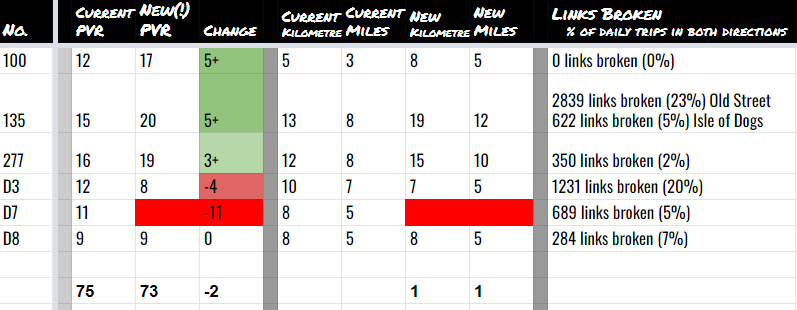 |
| My estimated PVR/length changes. 3175 links broken (5% of trips in both directions) |
-------------------------
London Bridge + Tower Bridge
The 43 47 388 + 78 388
Starting off with the withdrawn route, the 78.
Nunhead not being replaced leaves a lot of pressure on the P12 and dare I say Thameslink between Peckham Rye and Nunhead. I admit to having thoughts on it being a quieter section but at peak time 78s do get busy from Nunhead. So fully loaded double decker buses being left without replacement and telling people to use an already busy P12 is nothing short of deluded.
Not to mention a toilet was installed for drivers only at best 4 years ago, so without a bus route terminating there that is a waste of money.
Le 388; adds many links but the removal of a Peckham to Aldgate link in terms of 78 going away wouldn't be harmful if the 343 wasn't also cutback. Instead, Peckham gets an extra link to London Bridge for the better or worse, but without doubt Tower Bridge's tendency to close-open-close at any time would harm a lengthy route to Stratford City in the form of ever-changing 388.
I doubt people would use it for long distance to places like Bethnal Green or Hackney Wick, perhaps Hackney Central if it went there, though it's a nice to have I suppose. Even if in reality it's taking advantage of 78's contract expiring so combining 78/388 was easy to do.
Next on the two cutbacks, 43 and 47.
It's no secret the 47 suffered during the era of roadworks and it was previously cut back from Shoreditch in 2016 to Liverpool Street with a brief stint at Tower Bridge Road then returning to Shoreditch in 2017. It seems usage recovered only slightly, it would be beyond optimistic if people returned in droves after a year of it being cut. This is in addition to a massive frequency reduction with a near-useless Sunday frequency. Whilst the link to Liverpool Street is useful in the day albeit not used as much perhaps, the bustling night life of Shoreditch retains the 47 in the form of N47.
The 43 is one I didn't expect but equally a route I am unfamiliar with in person. It does seem to armchair-me that it's service levels are unbalanced, since it's frequency is definitely needed in the northern section where 43/134 provide a service to the only pockets of North London without tube/rail. The only thing I'll add is that 43 returns to serving Liverpool Street, something it used to do on Sundays for Spitalfields Market from 1998 to 2004 (the market almost went away recently).
An interesting choice is it's night route is unchanged, becoming N43.
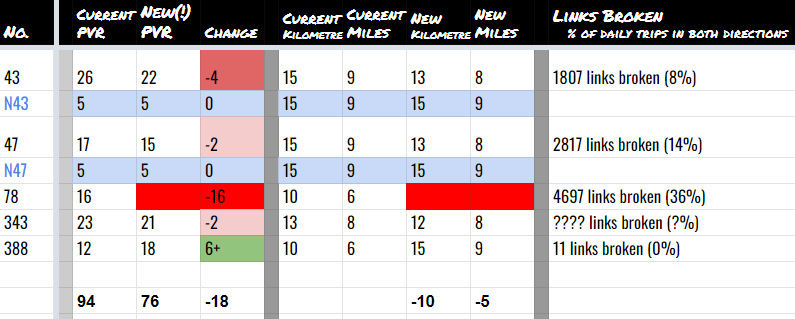 |
| My estimated PVR/length changes. London Bridge: 4624 links broken (9% of daily trips in both directions) Tower Bridge: 4179 links broken (19% of daily trips in both directions) |
-------------------------
According to the Equality Impact Assessments, the total amount of links/journeys broken:
24870 links broken,
My estimates of:
PVR change of -55. Length change of -31 km -18 miles.
 |
| GIF: Current and Proposed |
--------------------------------------------------------------------------------------------------------------
West London
routes 14 72 74 C3 N74 withdrawn
changes to routes 19 27 49 272 283 328 414 430
new routes N414 N430
-------------------------
Earls Court
The 27/328/C3 (and N31)
Many would suggest that in order to withdraw the C3, you'd need to involve the 306. Maybe 295. Perhaps both. Maybe even 28. Instead the choice was 27 which is bizarre at first but if you think about it from a data perspective (and links retained) it makes sense.
In a rational enthusiast sense, you'd extend 306 from Sands End via C3 to Clapham Junction, perhaps then send 328 to Sands End. Alternatively reroute 295 via Imperial Wharf to Fulham Broadway with 306 taking Wandsworth Bridge Road.
Rerouting 27 at High Street Kensington via Earls Court, Imperial Wharf and Wandsworth Bridge allows not a single one of C3's links to be lost. So far you've seen earlier proposals in East and South with major losses of links. In addition it gives Imperial Wharf a night service which it didn't have. Whilst this gives positive spin in the consultation there is a modus operandi behind that. N31's withdrawal.
Another reason for 27 (24-hour route) going via Earls Court is that it covers a loss of N31 which also serves Earl's Court. Withdrawing N31 also means Battersea Bridge Road isn't overbussed during the night, whereas having only one route between Notting Hill and Camden means there won't be interworking needed between N28/N31 at a frequency with even split, allowing N28 to be on it's own at every 20. You can't have two routes joint at every 20 (one route at every 40 each) work under a relatively perfectionist TfL frequency structure.
Alas, C3 is a short route with relatively little traffic issues barring the obvious at both termini so an extension per say of 27 might not harm it's reliability too badly, though I wasn't and probably won't be convinced until I am proven wrong in the future. I mainly say this given 27's frequency which is lower than in it's past happier days of the last decade.
The motive for rerouting 328 stems from it's complicated Chelsea stand arrangement which has been a thorn in their backside for some time. During the day (06:30-23:00) it uses Limerston Road then during the night (23:00-06:30) it uses King's Road slightly further ahead. If you thought residents were an issue you are correct. This was the compromise from the 31 era until now and it seems TfL are doing away with complicated arrangements where they can in this convenient cuts-spree. There was word of 328 being extended via Battersea Bridge to Battersea Power Station, where many were concerned of traffic issues it would face.
Perhaps 328 could've been rerouted at Earl's Court to Clapham Junction via C3 thus negating the need for 27?
Yes and it seems to be a more plausible idea than involving 27. If my assumptions are correct, then 328 would have to be 24-hour in order for that extension to happen because remember, N31 is dying along with 31. You would leave Earl's Court without a night service to Notting Hill or Clapham Junction without replacement, a foolish idea considering thus far no night link is broken without an easy hopper fare doable. At the same time it saves face considering Earl's Court has venues and the night life to back it.
Continuing on, if 328 were to become 24-hour in this fictional scenario, you create a new overbus problem at the northern end with 139, whereby already during the day there is more capacity provided than used ever since 139's extension from West Hampstead to Golders Green.
Simultaneously, the 328 going to Hammersmith instead of 27 remaining at Hammersmith also removes another night route from Hammersmith Road, well two as 23 and 27 both leave. This makes N9 the sole night route there which seems bad, probably will be. Though that is what the head honchos decreed.
Personally I was on the camp of involving 306 instead, but since I've delved into making calculations for these, I would back a 328 to Clapham Junction as a 24-hour route instead, with 139/189 being changed so 328 becomes the sole route from West Hampstead to Golders Green again. A 139/189 basically merger into a Waterloo to Brent Cross route which also solves the overbus along Abbey Road.
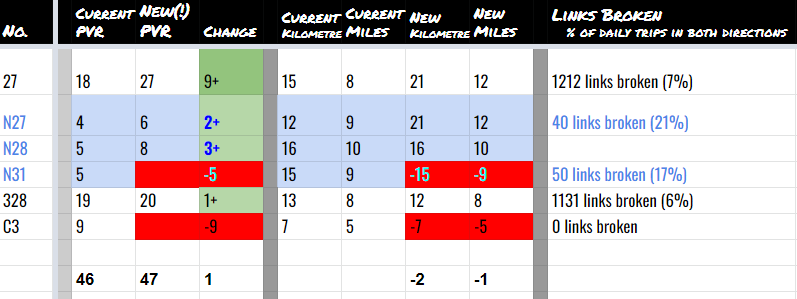 |
| My estimated PVR/length changes. 2343 links broken (6% of trips in both directions) |
-------------------------
South Kensington
The 14 19 49 72 74 272 283 414 430 (N19 N72 N74 N414 N430)
The 14 and 19/N19.
One thing for sure is the short lived Russell Square link is gone, inherited from the 10, meant to be given to 3 but instead for the 14 in a short sighted cut of 134 from Warren Street. Now the link risks vanishing altogether.
Technically "14" is rerouted to Marble Arch, I'll be more specific towards the end of this segment in the last paragraph regarding 14/74/414/430/N414/N430. Therefore 19 reverting to it's previous frequency to quasi-replace 14 along Piccadilly and Shaftesbury. Not much to say about that, other than them not changing 19's termini and simply rerouting it means they've learnt their lesson from the previous 11/19/22/311 fiasco years back. They could've extended 19 to Clapham Junction, I bet Chelsea would be happy.
The 49 and 72 and 272 and 283 and N72.
I wonder exactly what was wrong with it's section between South Kensington and Clapham Junction, it is a well used route after all, and a quick one at that end-to-end, reaching from South West to West in a jiffy. Now you'd have to change buses (I guess jump on the Overground but TfL haven't said that, unlike with D3). Perhaps instead of outright cutting it at South Kensington, they could've sent it to Battersea Power Station instead of the 211.
The more pressing thing is 49 is being used to replace 72!
They're already extending 272 to replace 72, giving 272 a 1 bus per hour increase to all of it's frequency levels (as 272 is currently every 15, the 72 is every 10), they could've just increased 283's frequency instead to cover a loss of 72. The 72 and 283 share a lot in common now that they're both short routes whom neither cross Hammersmith Bridge. The same can't be said for N72 which crosses Putney Bridge, which unfortunately puts it in clean way of 220 and N74 which meant it paralleled more routes than it could offer new links and thus, dies.
I can't conceptualise the loss of N72 as neither a user nor local but the amount of links lost from withdrawing it says enough for me.
The 283's extension to Hammersmith Bridge North Side replaces 72 easily. One for one. Both are single deck. Both are every 10. Both go to Hammersmith, Shepherd's Bush, East Acton. Easy peasy lemon squeasy.
Oh well, East Acton gains a direct link to Kensington, whether they appreciate it or not, plus a backdoor access to Westfield which is seemingly less attractive than 72/283's current routeing.
Finally, 74/430.
You'd think the simpler option is extending 74 to Roehampton, though they've taken the reverse strategy in keeping 430 as is but with a reroute so 430 serves Earl's Court instead of Old Brompton Road, leaving C1 on it's own there for better or worse, but serving Earl's Court keeps 74's links intact. Another aspect is 414 essentially replacing both 14/74 in that, 414 is the Central link to both 14/74. The 414 will remain at Marble Arch which 74 goes to. The 430 doesn't replace it. There was word of 430 being extended to Marble Arch to replace 74 but turns out, either that went to the drawing board for changes or was just similar rumours, but alas, one route dies. Realistically it's "74" that will survive, just 74 will die. Do you get what I mean?
Operationally, the 414's contract remains intact. Conveniently it's the more frequent route (414 is every 8, the 14 is every 10), and Go-Ahead's 14/74/430 contracts are rather exorbitant given they're the only bidders and they exploited that to successful degrees which is to TfL's detriment. Seems Putney (AF) is, after being the martyrs of the frequency cuts, now paying very dearly for contract prices.
One extra thing I've picked up on as I've been plotting routes in my spreadsheet is, the removal of garage terminators, this case it's route 74. Which technically uses Putney Heath during the evenings and early mornings, since Putney (AF) bus garage itself has a residence complex above it which limits hours of use understandably. Thus, eliminating 74 altogether eliminates many problems with few stones.
Simultaneously the 430's contract price (currently) is lower than 74's. £7.35 per mile of 74 versus £6.88 per mile of 430. Understandably as 430 has a lower PVR and less intensive in traffic.
All in all with the 414 430 N414 N430 numbers remaining/birthing, I suspect they want a repeat of 13/82 whereby residents had a harsh response to the historic number 13 going away, the same will happen with 14 and 74.
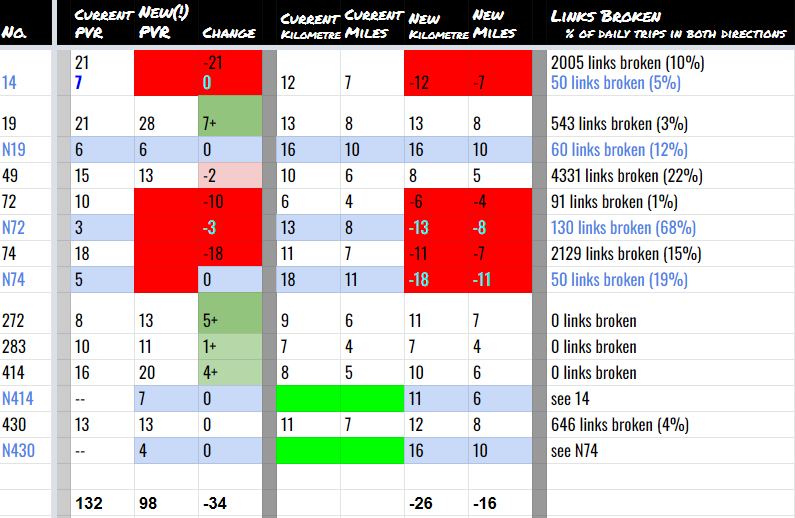 |
| My estimated PVR/length changes. 9746 links broken (10% of daily trips in both directions) |
-------------------------
According to the Equality Impact Assessments, the total amount of links/journeys broken:
12089 links broken,
My estimates of:
PVR change of -33. Length change of -28 km -17 miles.
 |
| GIF: Current and Proposed |
--------------------------------------------------------------------------------------------------------------
North London
routes 16 24 31 349 N16 N31 withdrawn
changes to routes 6 23 88 98 113 189 205 214 254 259 279 N98 N205
new routes N32 N189
-------------------------
Baker Street proposals
The 31/113/189
Looking briefly at the Equality Impact Assessments for the Baker Street changes, it mentions 8000 journeys broken. Which should be no surprise given the changes made.
The 111-year old route 31 withdrawn, replaced by a haphazard reroute of 113 which sees it become a 14 mile route adding at least half an hour to it's existing end-to-end time. Whilst the 189 being rerouted away means Brent Cross loses it's two central links by day (routes 113 and 189), but retains night route N189 and no change to N113. This when a new Brent Cross West development is to spring up in future.
Upon reading this I was pretty vocal to myself regarding the 113, since it's a quick service from Central London out into Zone 6 in Edgware, since it uses the A41 which is predominantly high speed (40mph or 50mph) for most of 113's route. It's no secret it's cut from Oxford Circus to Marble Arch in 2009 hurt it's existing users, so when it was re-extended as compensation for withdrawing 13 (Aldwych-Golders Green), it didn't have the same amount of patronage as it did pre-2009, but still was a welcome route in the area. Even if it now terminates at Marble Arch it is still valued, where patronage starts picking up.
It felt like an eventuality for 113 to be cut back to Baker Street.
Instead the 113 is sent along Notting Hill which is congested (at least compared to 113's speedy but also trafficated nature) and onto White City. No doubt you could get a 316 and change onto 32 and end up quicker than doing 113 end-to-end some would say, and I wouldn't doubt them.
Another thing of note is 31's extension from Notting Hill to White City, whilst it created a nice round-the-corner link to the brand new Westfields shopping centre, the section is debatable in it's value, at least compared to unfortunately much busier parallel routes in 94 and 148.
The 113 which only intersects the 31, becomes a new route with half the identity of 31 and half it's 113 identity, a confused route that believes it has more purpose than it actually provides.
Route 189 however is less of an issue per say, as it is the less preferable route to go Camden. Ever since it's cutback from Oxford Circus to Marble Arch and accompanied frequency reductions, it's purpose along Abbey Road went from an alternative to 139 into something more akin of an alternative of 139 that stops short. The reason for it's cutback relates to 13/113 Finchley Road fiasco whereby 113/189 swapped termini.
A more sensible change involving 189 would be to fuse it with 139 to provide a Brent Cross to Waterloo service, involving a change with C11 too to keep the West Hampstead link. For what it's worth, Brent Cross keeps it's night link to Marble Arch which is still short of genuinely useful.
The 189 which shares some stops with 31, becoming a route that separates from 139 altogether but returns to it's root of terminating at Kilburn Park, but extended to Camden Town.
All in all, I suppose does create new links, coupled with 113 also headed from Swiss Cottage to White City means the core Kilburn section which was once 31-only now has two routes which sees a previously overcrowded section (due to 31 having a massive frequency decrease circa-2019) given a massive capacity increase. The cost being, you can't get from Camden to Notting Hill without changing, that's not to add other destinations/points of interest.
Postscript: The 113's frequency would be changed to every 10, matching 31's current frequency and thus saving more resources. The route will fall apart if it came to reality.
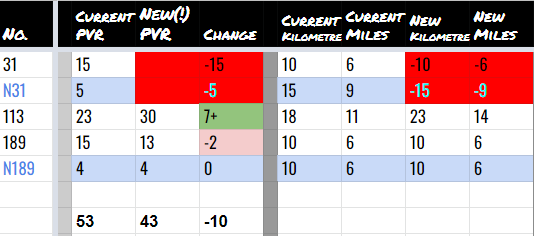 |
| 7058 links broken (13% of daily trips in both directions). My estimated PVR/length changes, which is thrown off by 113 seemingly being decreased to every 10. |
-------------------------
Caledonian Road proposals
routes 254 259 279 349 N279
I say this since I am in the process of creating the post as opposed to first thoughts (it's literally a week since it dropped) but in the fine print of the Night Bus document (in the Equality Impact Assessments) mentions the N279 to be renumbered N259, along with other 24-hour routes which I've already mentioned or will mention.
N279 aside, my thoughts on the change? The 349 being withdrawn isn't sad to me as a non-local and an equivalent route here wouldn't be as such. It doesn't offer unique links nor has sections to itself, after all it's the replacement of when 149 used to go Ponders End but was cut back due to it's conversion to articulated single deckers and subsequent conversion to a 24-hour service, thus it was split into a less frequent double deck route (349) and major frequent bendy route (149). Seems 149 probably should have remained at Enfield Bus Garage instead.
The 259 makes it's return to the area funnily enough in another nostalgic nod to history change, as the tramway near the garage was 259's terminus for a long amount of time until fiddled around, now Edmonton Green is it's terminus. It will also go back to it's original pre-2019 frequency (it got two frequency decreases since then until now).
In the end, it's probably more fiddling than needed, but if they increased 279's frequency (which seems the easier way out), they'd inflate an already high PVR route with more contractual costs, which TfL have been doing their best to cut (see 25's restructure in 2018?) So the route to increase became the relatively-low PVR route 259... going back to it's original PVR more or less.
 |
| My estimated PVR/length changes. 4890 links broken (5% of daily trips in both directions). |
-------------------------
Edgware Road
The 6/16/23/98
On the whole, the better set of changes even if it means Cricklewood loses it's well used Victoria link, but other links remain mostly intact.
Kilburn to Victoria will have 98 instead of 16.
Paddington regains it's Trafalgar Square and Aldwych links albeit via Piccadilly which could be time killing.
The 6 returns to Oxford Circus. Between 6 and 98 one could argue the 6 was more valuable, so can it regain it's previous popularity? That is to be seen in future.
A mostly touted suggestion by the enthusiast space was involving the 332. Or perhaps renumbering 332 to 16 and calling it a day. Since the high profile route number 16 will spark controversy, that could be the future answer, lest 98 become 16 to Willesden. The 98 is only 30 years old, having replaced 8 to Willesden.
The 23 keeps changing terminus, can't decide if it goes Liverpool Street, Aldwych, Liverpool Street, Aldwych, potentially Wembley, potentially Lancaster Gate, Hammersmith, now Aldwych is back in the list.
At this rate on the day I was exhausted, now I am trying to find what more I think of these changes. I don't have anything question in a negative light. These are cuts at the end of the day so there isn't positives to run home about.
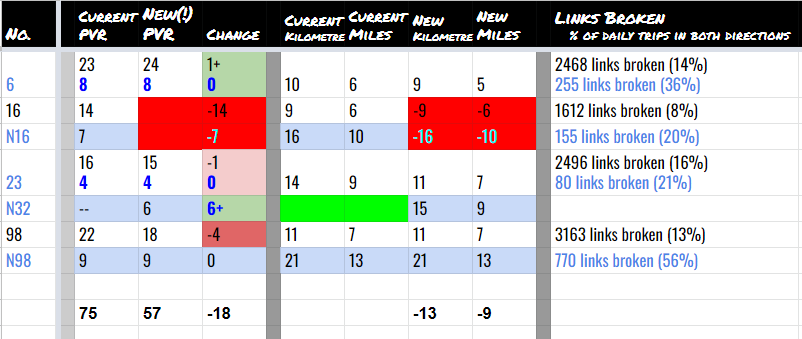 |
| My estimated PVR/length changes. 9740 links broken (12% of daily trips in both directions) |
-------------------------
Euston Road
The 24 88 205 214 N205
It was judging by the reactions of others that I gauged 205 would be the one I'd dread the most and boy did I have a virtual heart attack but not a real one, as I wouldn't be writing this.
So instead let's leave 205 for last.
The 88.
It going to Hampstead Heath to replace 24 is a sound idea if you think about it. The 24 and 88 share similar links, it's just 88 goes via Oxford Circus with 24 going via Tottenham Court Road. This change sees 88 go via Tottenham Court Road as well. So on the surface, not a bad change.
This does mean 88 has killed a lot of routes in total: 135, C2, now 24.
Oh well, many have thought of only keeping the Pimlico-Victoria and Camden-Hampstead ends of the route, using any Victoria terminator (13 or 16) and at the other end extending the 27, but TfL instead opted to have it entirely intact in some shape or form.
The 214.
This realistically just becomes current 88 single deck going to Pimlico. The only section 214 keeps is the one section it had added to it since birth. Until Crossrail works happened causing 214 to be cut from Liverpool Street to Moorgate, 214 unlike other central routes never had a cutback at all... until that happened. Now it faces losing it's entire city identity. One thing I thought of was how in the past a direct route from Parliament Hill Fields to Plumstead Common called the 163 was cut in the 1970 changes which had opposition (but to no avail) with many citing the loss of a link to Oxford Circus and Trafalgar Square, with some residents having gone as far as Woolwich. The 3 (subsequently 53, subsequently C2, subsequently 88) brought some of those links back unironically. The reverse will happen with them losing their city link in the form of their long standing 214. That I imagine will be touching a lot of nerves considering how long 214 has remained virtually the same.
The next thing is, it's a single deck route owing to a low tree restriction on Highgate West Hill. TfL don't seriously want to convince it will replace the 88, granted 214 is every 7-8 whilst 88 is every 10. The 214 has frequency to offset it's capacity, but would that truly be enough? Or rather, would it be justified, if service levels could be lower with higher capacity vehicles?
Boy oy boy we came to the 205.
Which should evoke more anger, the loss of it's Mile End-Bow section which relieves a busy 25, or the section it follows the basically-nonexistent-Hammersmith&CityLine? The answer is both.
It seems the route they decided to remove from the slightly-overbussed Euston Road was not the 30, not the 18 (which would evoke significantly more response and issue), but the newest route in the block in the form of 205. Whilst the 205 has less clout than 30, it is argued and debated that 205 is the more valuable route on the corridor than 30. Despite, or perhaps because, it parallels the corridor religiously from Paddington through to Aldgate. If the 18 was sent to King's Cross that would soften the blow and remove issues regarding it's stand being smaller than it is, alongside future issues with High Speed 2 basically bulldozing Euston.
The eastern section being cutback effectively forces you to make two options: Take a (probably) crowded 25, or get the District/H&C instead. Oh yeah, Elizabeth Line also exists now doing Paddington to Liverpool Street. Conveniently only been a few weeks since it opened.
So the 205 is really a 214 cut from Highgate to Parliament Hill, but extended from Moorgate to Mile End, with N205 also changing.
The N205 being cut from Paddington also means the really frequent night 214 is replaced by a sole N205 which is almost half it's frequency, which I guess means only one night route is necessary along City Road between King's Cross and Old Street.
It was at this point I struggled to form words to describe my frustration at this change but as I write this post I will instead remain professional and leave it there, simply saying "I disagree with this change." End of story.
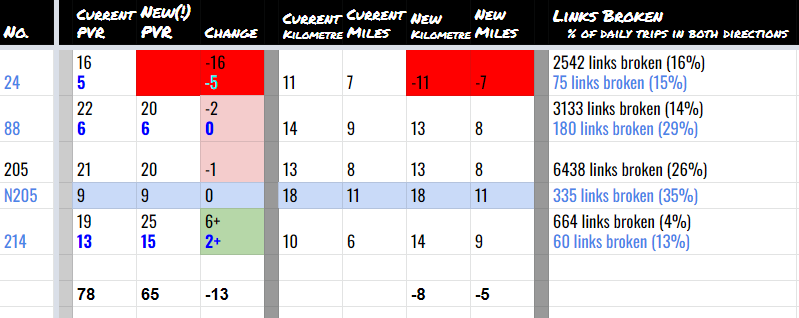 |
| My estimated PVR/length changes. 12777 links broken (16% of daily trips in both directions) |
-------------------------
According to the Equality Impact Assessments, the total amount of links/journeys broken:
34465 links broken,
My estimates of:
PVR change of -52. Length change of -38 km -24 miles.
 |
| GIF: Current and Proposed |
--------------------------------------------------------------------------------------------------------------
It's almost as if these changes involving killing the historic route numbers are deliberate, to generate traction. Since people already lamented the withdrawal of the 13 (Golders Green-Aldwych), then TfL went with round 2 by 'withdrawing' the 82 but in reality renumbering the 82 into 13.
Perhaps political, with Conservative members of parliament along some areas involved, perhaps route 31's controversial change. Those living in Chelsea, Dulwich, Hampstead and Putney will all have very heated words sent to TfL and by consequence the Mayor and Prime Minister's way.
Ever since I've finalised this post, Conservative MP Gregg Hands made a petition for his constituents (involving routes 11 14 and 74). As expected, the consultation is causing a scene, to that end it's a success. Though in the end, cuts will come one way or another, and is only a success for TfL's waning finances. Cuts reduce revenue which further lowers the money pool which means more cuts should be made... a negative feedback loop.
Some of the ITTs for the to-be-withdrawn routes were paused as a result of this exercise, moved into separate tranches with a "C" suffix after the tranche number.
Then, routes 32 108/N108, 189/N189, 321/N321, 381/N381 were moved into separate tranches, whilst the 632 which was in tranche 812 wasn't awarded and extended a year.
It's no secret for some of these routes, contract trickery will commence, in the same way when 13 (Aldwych-Golders Green) died it's contract transferred to 139 (Waterloo-Golders Green) at a time when 139's own contract was near expiry.
So to conclude, yes there is scope to reduce some of the fat in the bus network.
Yes by technicality most of these changes retain links. Perhaps some of those links didn't have to be kept whilst valuable ones were thrown to the wayside.
Yes low number routes dying is a 13/82 charade being used to full effect.
Perhaps there are better ways of restructuring routes to better balance resources, and certainly without killing major links.
In the first place at the start of Covid, if the temporary cuts were more drastic, permanent cuts wouldn't have to be as drastic in the now. Though that's saying much for a TfL scuppered by Alexander Boris de Pfeffel Johnson.
To that end, I bid you a good farewell for the coming while, I hope you enjoyed this post nonetheless, as much as the consultation threw my next post schedule to disarray so I won't make promises on future posts, but I have a backlog now for better or worse. So stay safe until then!
-------------------------
Sources and Links:
Ham and High article (24 31 88)
Southwark News article (12 45 78 521)
Brixton Buzz article (45)
Inner London document, South/West document, North/East document (all by YX10FFN)
.

No comments:
Post a Comment